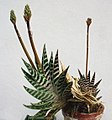
This tender evergreen succulent is also known as tiger aloe so can join the cat or bird parts of a plant zoo. The stripes on the leaves beg for inclusion with other cat plants but the white spots on the leaves that create the look of a phaesant’s breast suggest a placement with other feathered friends. In addition, its small size and preference for partial shade recommend it as a house plant. Considered one of the most attractive aloes, it has been cultivated since 1695 when it was part of the Dutch East India Company’s garden in Cape Town. Native to arid and semi-arid regions of South Africa and Namibia, it likes dry conditions and thrives in hard ground, between rocks, and in rocky crevices.
Plants grow up to 1′ tall and wide and form stemless rosettes of 18-24 triangular-lanceolate leaves that are 4-6″ long and 3-ranked. The leaves have small white teeth on their white horned margins and are dark green variegated by whitish spots that form irregular bands. They may take on a reddish color when water is lacking. In winter short, stout, mostly branched stems give rise to pendent flowers that are up to 18″ long and are usually orange with green edges but may be red or rarely yellow.
Type: Tender, evergreen perennial succulent
Height: Up to 12″
Bloom Color: Orange with green edges
Bloom Time: Winter
Light: Partial shade
Soil: Soil: Fertile, dry, very well-drained
USDA Hardiness Zones: 9-11
Photo Credit: Wikipedia